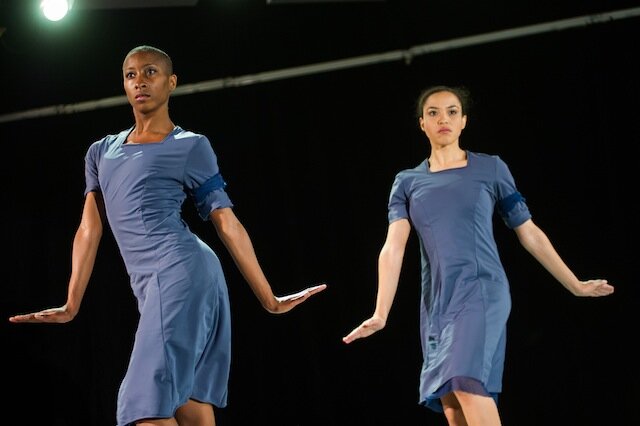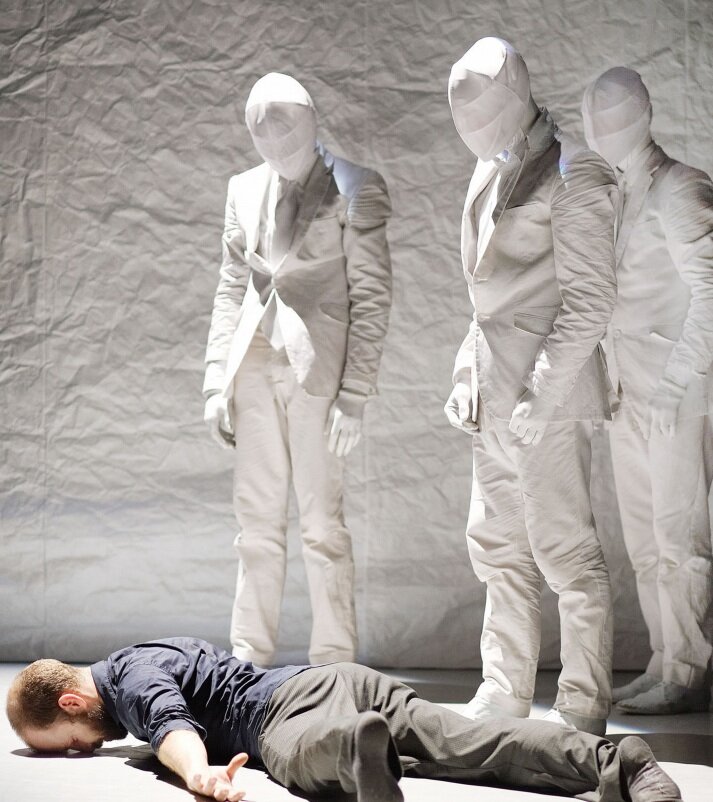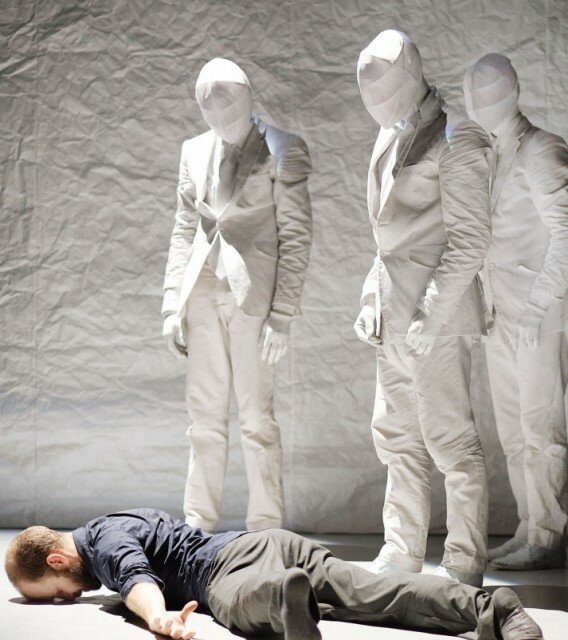More frequently in Seattle these days, you might catch yourself in an act of arts-going self-envy.
Where typically you might be reading about a blockbuster week in New York, or Edinburgh, or Avignon, and wishing yourself there, this week you could attend back-to-back performances of Kidd Pivot‘s The Tempest Replica (our review) at On the Boards and Spectrum Dance‘s Theater of Needless Talents (at the SDT Studio through October 28; tickets). These are both major works, and that’s following last weekend’s City Arts Festival, which itself set a new benchmark for arts installation and performance curation in Seattle.
This matters because however the arts move you–maybe they elevate, maybe they take you downtown–they can only move you so far, singly. But together, they can shift your center of gravity, fragment your perspective, create new harmonies. Urban density makes a city take place–arts density makes minds take place, just as if you were walking along a Jane Jacobs sidewalk, encountering artworks as you go. (She called it the “ballet of the good city sidewalk,” in fact.)
It’s an engine of serendipity, letting you tussle with Shakespeare one night, and a response to the Holocaust the next, and in so doing, witness the construction of a city of cities.
To bring this back down to earth, consider choreographer Donald Byrd’s statement that, with The Theater of Needless Talents, he wanted to get into how particular humans keep finding ways to commit atrocities against humanity. Rather than totalizing Nazi power, buying into the Reich’s myth, his work, iconoclastic as ever, breaks it into pieces: At the outset, members of the troupe recite the statistics of who killed, who was killed, where they lived–you see a spate of killings, setting off more killings. Contingency re-enters the history.
The stark set (designed and originally lit by Jack Mehler, with lighting here by Rico Chiarelli) is a bare floor, with a square box taped out, divided into tic-tac-toe format; above the dancers are blocks you surmise are inspired by the Berlin Holocaust Memorial. The plain curtain is sketched out in the style of Terezín artworks. That, in conjunction with the period-ish (for dancers’ purposes) costumes by Jessica Markiewicz is all that’s needed to create the dread and (fatalistic) joy of the era.
Byrd is fascinated in this piece, slightly revised for these performances, by what’s known as “negative capability,” defined variously, but most famously by Keats as an ability to meet manifold reality without filtering it through your identity first. For Byrd, the cabaret-style performances in the concentration camp Terezín are emblematic of this state of mind. Was it a courageous way to reclaim their humanity? A form of denial? Submission to Nazi whim? A morale boost? Was it all of these things?
In composer Erwin Schulhoff, who died in a concentration camp in Wülzburg, Bavaria, Byrd has found a fellow iconoclast and outsider, with a similar taste for experimentation in forms and genres. The work uses Schulhoff’s Duo for Violin and Cello (1925), Hot Music, 10 Studies in Syncopation; 5 Etudes in Jazz; Suites Dansant en Jazz; and the second movement from his Sonata for Cello and Piano (1914). Performers are pianist Judith Cohen, remarkably adept at bridging classical and jazz; and violinist James Garlick and cellist Rajan Krishnaswami, the last of Simple Measures, who drew bravos during their bows.
At times, Byrd has used dance to find the extremes in music; here, the music is in extremis, and his choreography, often tender. Where it startles–a dancer drops to the floor as if shot in the head, early on, though the dance continues–it is not dramatic so much as an intrusion of that reality. I think a book could be written about the difference (it is anti-dramatic to lose people randomly, when the murder is no mystery), so I have to leave it at that: the impact of subtraction.
Derek Crescenti acts as a mouthpiece for former camp members, and his forceful, direct delivery does not need any “for a dancer” qualifications. The remembrances of prisoners (when a guard told a child her mother was probably that smoke over there, coming out of that smokestack; when Mengele sewed the twins together; when an inmate realized he felt giddy at not having to worry about being put in a concentration camp anymore, since he was in one) set up the scenes that follow, though Byrd is very attentive to the music, so there is juxtaposition as much as dramatization.
Shadou Mintrone gets comedic dances, with Chaplinesque pratfalls, big grins, jazz hands–all tinged with the hysteria of someone driving themselves not to crack, to lift the spirits of others. Jade Solomon Curtis does crack–her index finger practices becoming a gun to her temple, again and again. Donald Jones, Jr., and Kate Monthy dance a torrid, bittersweet duet with an invisible third member, the prospect of separation. Bodies knot up, bend into impossible shapes, lock themselves to each other. Bodies shake, go limp with illness, exhaustion, and yet there’s always someone so hungry for human touch that they can’t let go, who lifts the body like luggage they’ll carry with them.
People were not always made into different or better people by circumstances: Ty Alexander Cheng is caught between two women, Mintrone and Cara-May Marcus, and if one falls, another is there to pull him in. Marcus has the expressive face of a silent movie star, and she is not always in control, but you can’t look away. Just as Schulhoff interpolated jazz, Byrd brings in popular dance, a few steps, a tango-like series. Hands slap the flat of the inner thigh like percussion, and punishment. Marcus curls into a ball in Cheng’s arms, but woman also support men, lift them up. In a short, heart-breaking sequence, Vincent Michael Lopez and Derek Crescenti portray a gay couple whose embraces are both a desperate solace and furtive.
At the close, Byrd revisits the earlier recitation of statistics, his troupe updating them into a roar of what sounds like ceaseless slaughter since World War II. In the program notes, he quotes President Obama: “Awareness without action changes nothing.”
Then consider the coincidence that, for Keats, the master of negative capability was Shakespeare, author of The Tempest. In Pite’s telling–which opens with Prospero (Eric Beauchesne) triggering Ariel (the incredible Sandra Marín Garcia) with the phrase “shipwreck,” and an astonishing cinematic spectacle of projected rain, billowing gauze curtains, and dancers rolling on a “pitching” deck–negative capability is humanity. Up until Prospero lets himself take in what is present before him, his frozen vengefulness (its origins told in an enrapturing shadow-puppet show) is in turn recapitulated in his puppetry of actual people.
Because this is an interpretation, I think there’s a case, as well, for considering the players to be wrapped in folio parchment, so that Prospero’s regained humanity emerging is doubled by Pite’s choreography emerging from the text, its story. There are other, structural reasons this is intriguing–the second half is all human blossoming, both in pain and regret and anger, and in joy and expression and freedom, in counterpoint to that shipwreck spectacle, and yes, I think it’s interesting which you prefer–but side-by-side with Needless Talents, there’s that framework again of cruelty, imprisonment, and humanity hard-pressed but unconquerable.
To see both of these works is to be impressed, literally, by them. They leave a mark, they layer maps onto you, leaving everything strange and yet more real than before. You are their conversation.






